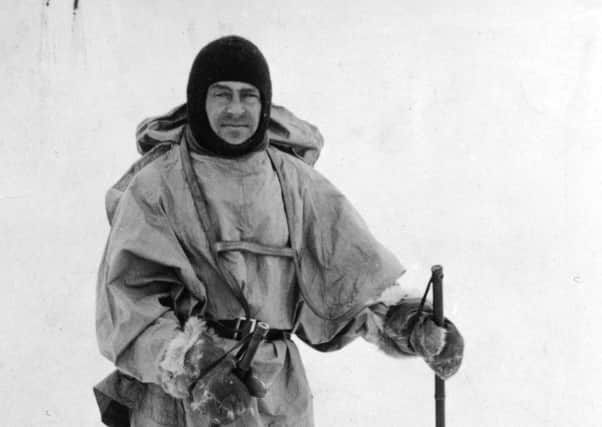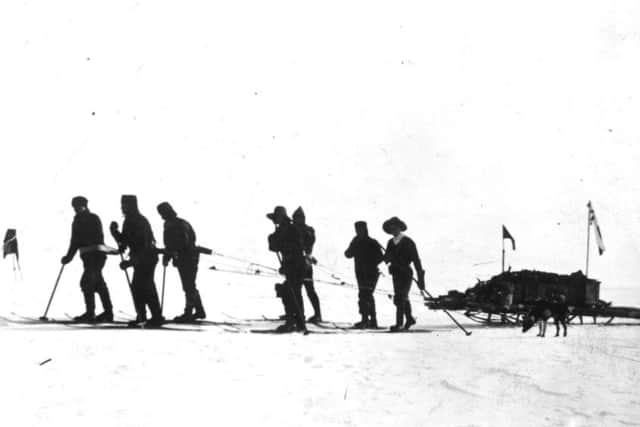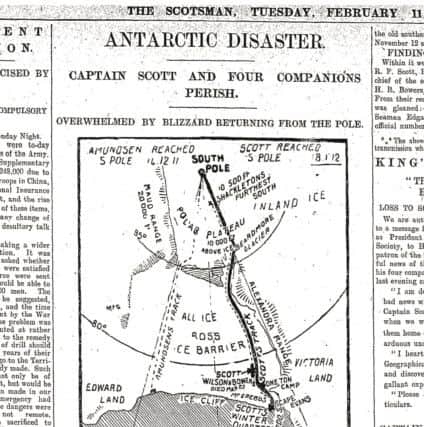Scotsman 200: News of Captain Scott disaster travels slowly


INTRODUCTION
The tragic story of Robert Falcon Scott – or “Scott of the Antarctic”, as he became known – hardly needs any introduction. What is notable about The Scotsman’s report of his death reproduced below, however, is the timing of it. Scott and his companions, Edward Wilson and Henry Bowers, are thought to have died in their tent on 29 March 1912, but in the early part of the 20th century, news of events in remote corners of the globe still travelled slowly. The men’s bodies weren’t discovered by a search party until 12 November 1912, and it wasn’t until 11 February 1913 that The Scotsman was able to tell its readers that Scott and his team, having been beaten to the South Pole by the Norwegian Roald Amundsen, had been stranded in a blizzard just 11 miles short of a food depot that could have saved their lives and subsequently died of exposure. Even then, almost a year after the event, the report breaks off half-way through and a note at the bottom reads: “The above message was still in course of transmission when we went to press.”
Also significant is an article accompanying the news story written by William Speirs Bruce. Criminally under-appreciated during his lifetime, Bruce had led his own Scottish Antarctic Expedition in 1902-4, and completed a full programme of exploration and scientific work that included the establishment of a manned meteorological station, the first in Antarctic territory. When he praises the scientific achievements of Scott’s expedition here, then, he is speaking with a considerable degree of authority.


FROM THE ARCHIVES: TUESDAY, 11 FEBRUARY, 1913
Antarctic disaster.
Captain Scott and four companions perish.
Overwhelmed by blizzard returning from the pole


CHRISTCHURCH, NZ, Tuesday 8AM
Advertisement
Hide AdAdvertisement
Hide AdThe Terra Nova, which went South to bring back, as it was hoped, Captain Scott and the other members of the British Antarctic Expedition, arrived at the base at Cape Evans on January 18 of this year, and obtained the following information there from the shore party:-
Captain Scott reached the South Pole on January 18, 1912, and there found Amundsen’s tent and records.
On the return journey the whole of the Southern party perished.


Captain Scott, Dr Wilson, and Lieutenant Bowers died from exposure during a blizzard about March 29, 1912, and their last camp, 11 miles to the south of the “One Ton” depot, or 155 miles from the hut at Cape Evans.
Captain Oates died from exposure on March 17, and Seaman Evans died from concussion of the brain on February 17.
The health of the remainder of the expedition, including Lieutenant Campbell’s Northern party, who wintered in Terra Nova bay, is excellent.
STORY OF THE STRUGGLE


The history of the expedition is as follows:-
Before the Terra Nova left for New Zealand in March last, Surgeon Atkinson, who had been left in charge of the Western party until the return of Captain Scott, dispatched Mr Cherry Garrard and the dog driver Demetrie with two dog teams to assist the Southern party, whose return to Hut Point was expected about March 10, 1912.
Advertisement
Hide AdAdvertisement
Hide AdSurgeon Atkinson would have accompanied this party, but was kept back in medical charge of Lieutenant Evans, the second in command, who, it will be remembered, nearly died of scurvy.
This relief party reached “One Ton” depot on March 3, but was compelled to return on March 10 owing primarily to the food for the dogs running short, and also to the persistent bad weather and the poor condition of the dogs after the strain of a hard season’s work.
The dog teams returned to Hut Point on March 16, the poor animals mostly frostbitten and incapable of further work.
Mr Cherry Garrard collapsed as the result of having overstrained his heart, and his companion was also sick.
UNUSUALLY SEVERE WEATHER
As it was impossible to communicate with Cape Evans, the ship having left and the open sea intervening, Surgeon Atkinson and Petty Officer Keohane, the only two men left, sledged out to Corner Camp to render any help that might be wanted by the Southern party.
They fought their way out to Corner Camp against the unusually severe weather, and realising that they could be of no assistance were forced to return to Hut Point after depoting one week’s supply of provisions.
In April, when communication with Cape Evans was established, a gallant attempt to relieve Lieutenant Campbell was made by Surgeon Atkinson, Mr Wright, Petty Officer Williamson, and Petty Officer Keohane. This party reached Butter Point, but they were there stopped by open water. Their return was exciting, and nearly ended in disaster owing to the sea ice breaking up.
THE SEARCH PARTY
Advertisement
Hide AdAdvertisement
Hide AdA search party left Cape Evans after the winter on October 30 last. It was organised by Surgeon Atkinson, and consisted of two divisions, Surgeon Atkinson taking the dog teams with Mr Cherry Garrard and Demetrie, while Mr Wright was in charge of a party which included Mr Nelson, Mr Gran, Mr Lashley, Petty Officer Williamson, Petty Officer Keohane, and Steward Hooper. Seven Indian mules were taken with the second party. Provisions were taken for three months, it being anticipated that an extended search would be necessary.
“One Ton” Camp was found to be in order and all provisioned. Then proceeding along the old southern route Mr Wright’s party on November 12 sighted Captain Scott’s tent.
FINDING OF THE BODIES
Within it were found the bodies of Captain RF Scott, Royal Navy; Dr EA Wilson, chief of the scientific staff; and Lieutenant HR Bowers, of the Royal Indian Marine. From their records the following information was gleaned:- The first death was that of Seaman Edgar Evans, Petty Officer, RN, official number 160;225.
(The above message was still in course of transmission when we went to press.)
Further accounts of this story are available at the Scotsman Digital Archive